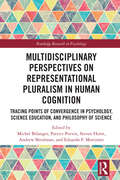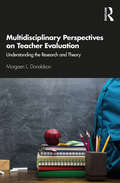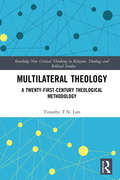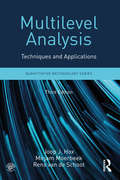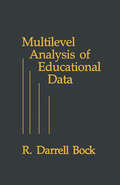- Table View
- List View
Multidisciplinary Perspectives on Representational Pluralism in Human Cognition: Tracing Points of Convergence in Psychology, Science Education, and Philosophy of Science (Routledge Research in Psychology)
by Michel Bélanger Patrice Potvin Steven Horst Andrew Shtulman Eduardo F. MortimerBringing together diverse theoretical and empirical contributions from the fields of social and cognitive psychology, philosophy and science education, this volume explores representational pluralism as a phenomenon characteristic of human cognition. Building on these disciplines’ shared interest in understanding human thought, perception and conceptual change, the volume illustrates how representational plurality can be conducive to research and practice in varied fields. Particular care is taken to emphasize points of convergence and the value of sharing discourses, models, justifications and theories of pluralism across disciplines. The editors give ample space for philosophers, cognitive scientists and educators to explicate the history and current status of representational pluralism in their own disciplines. Using multiple forms of research from the relational perspective, this volume will be of interest to students, scholars and researchers with an interest in cognitive psychology, as well as educational psychology and philosophy of science.
Multidisciplinary Perspectives on Representational Pluralism in Human Cognition: Tracing Points of Convergence in Psychology, Science Education, and Philosophy of Science (Routledge Research in Psychology)
by Eduardo F. Mortimer Michel Bélanger Patrice Potvin Steven Horst Andrew ShtulmanBringing together diverse theoretical and empirical contributions from the fields of social and cognitive psychology, philosophy and science education, this volume explores representational pluralism as a phenomenon characteristic of human cognition. Building on these disciplines’ shared interest in understanding human thought, perception and conceptual change, the volume illustrates how representational plurality can be conducive to research and practice in varied fields. Particular care is taken to emphasize points of convergence and the value of sharing discourses, models, justifications and theories of pluralism across disciplines. The editors give ample space for philosophers, cognitive scientists and educators to explicate the history and current status of representational pluralism in their own disciplines. Using multiple forms of research from the relational perspective, this volume will be of interest to students, scholars and researchers with an interest in cognitive psychology, as well as educational psychology and philosophy of science.
Multidisciplinary Perspectives on Teacher Evaluation: Understanding the Research and Theory
by Morgaen L. DonaldsonIn the wake of national interest in teacher evaluation, this book examines what we have learned about how and whether teacher evaluation holds teachers accountable and improves their practice. Drawing on literature in psychology, economics, and sociology, this multi-disciplinary and multi-perspectival book explores teacher evaluation’s intended goals of development and accountability, as well as its unintended consequences, especially as they relate to equity. Blending theory from diverse disciplines with decades of research, this book provides new insights into how teacher evaluation has played out in schools across the United States and offers recommendations for research, policy, and practice in the years to come. Insights include how to embed teacher evaluation in a larger culture of continuous learning; rethinking assumptions on accountability and development aims; and highlighting the importance of equity in the design, implementation, and outcomes of teacher evaluation. Every chapter concludes with practical recommendations informed by theory and research to guide policymakers, researchers, and district and school leaders as they seek to understand, design, and implement better teacher evaluation systems.
Multidisciplinary Perspectives on Teacher Evaluation: Understanding the Research and Theory
by Morgaen L. DonaldsonIn the wake of national interest in teacher evaluation, this book examines what we have learned about how and whether teacher evaluation holds teachers accountable and improves their practice. Drawing on literature in psychology, economics, and sociology, this multi-disciplinary and multi-perspectival book explores teacher evaluation’s intended goals of development and accountability, as well as its unintended consequences, especially as they relate to equity. Blending theory from diverse disciplines with decades of research, this book provides new insights into how teacher evaluation has played out in schools across the United States and offers recommendations for research, policy, and practice in the years to come. Insights include how to embed teacher evaluation in a larger culture of continuous learning; rethinking assumptions on accountability and development aims; and highlighting the importance of equity in the design, implementation, and outcomes of teacher evaluation. Every chapter concludes with practical recommendations informed by theory and research to guide policymakers, researchers, and district and school leaders as they seek to understand, design, and implement better teacher evaluation systems.
Multidisciplinary Research on Teaching and Learning
by Wolfgang Schnotz Andreas Müller Alexander Kauertz Heidrun LudwigThis collection indicates how research on teaching and learning from multiple scientific disciplines such as educational science and psychology can be successfully pursued by a co-operation between researchers and school teachers. The contributors adopt different methodological approaches, ranging from field research to laboratory experiments.
Multidisciplinary Research Perspectives in Education: Shared Experiences from Australia and China
by Indika Liyanage Badeng Nima“The editors of this extraordinary book, Indika Liyanage and Badeng Nima, have brought together a wonderfully wide-ranging collection of chapters. The breadth and depth of the studies of education issues in China and Australia are impressive. The topics encompass important questions concerning education policies, curricula, pedagogy, equality, parental engagement, cultural heritage, and anti-drug education. The scope of the book includes Chinese and Australian settings that range from kindergartens to higher education, and from rural to urban environments. The diversity of the book strengthens rather than weakens its coherence, because the golden thread running through all the chapters is a portrayal of the complexity of education provision when global, national and local forces interact. Written by academics with hands-on experience, the chapters provide evidence-based discussions of practical conundrums, enriched by the sophisticated use of interdisciplinary approaches. As a result, this book is powerful, challenging and ground-breaking.” – Bob Adamson, UNESCO Chairholder in TVET and Lifelong Learning, Education University of Hong Kong
Multifaceted Development: A Bangladesh Case Study
by Imtiaz A. HussainThis book focuses on the modernization of Bangladesh. It does so by including case studies at the national and sub-national government levels and comparative studies with other countries.Chapters in the book highlight how a number of aspects have been affected in the modernization process, such as the adoption of ‘western’ curriculum and English language in schools, the use of animation to boost school student comprehension of texts, the rural–urban divide, pedagogical training to emergent andragogy-dependent market needs, converting ‘local ’ shipping experiences to fill growing ‘global ’ needs, and multilateral environmental adaptation and mitigation mandates being adopted ‘locally.’
Multifunctional Nanostructured Metal Oxides for Energy Harvesting and Storage Devices
by Vijay B. Pawade Paresh H. Salame Bharat Apparao BhanvaseMetal oxide nanoparticles exhibit potential applications in energy and environmental fields, such as solar cells, fuel cells, hydrogen energy, and energy storage devices. This book covers all points from synthesis, properties, and applications of transition metal oxide nanoparticle materials in energy storage and conversion devices. Aimed at graduate-level students and researchers associated with the energy and environment sector, this book addresses the application of nontoxic and environmentally friendly metal oxide materials for a clean environment and deals with synthesis properties and application metal oxides materials for energy conversion, energy storage, and hydrogen generation.
Multifunctional Nanostructured Metal Oxides for Energy Harvesting and Storage Devices
by Vijay B. Pawade, Paresh H. Salame; Bharat A. BhanvaseMetal oxide nanoparticles exhibit potential applications in energy and environmental fields, such as solar cells, fuel cells, hydrogen energy, and energy storage devices. This book covers all points from synthesis, properties, and applications of transition metal oxide nanoparticle materials in energy storage and conversion devices. Aimed at graduate-level students and researchers associated with the energy and environment sector, this book addresses the application of nontoxic and environmentally friendly metal oxide materials for a clean environment and deals with synthesis properties and application metal oxides materials for energy conversion, energy storage, and hydrogen generation.
Multifunctionality in English: Corpora, Language and Academic Literacy Pedagogy (Routledge Advances in Corpus Linguistics)
by Zihan Yin Elaine VineThis edited volume provides detailed analyses of multifunctional forms in English and offers hands-on approaches exemplifying relevant implications and useful applications to language and literacy educators in TESOL, ESL/EFL/EAL and research students in applied linguistics and education. The chapters cover: the multifunctionality of utterances in spoken and multimodal corpora, the multifunctionality of linguistic creativity in different genres, multifunctional pronouns in hard and soft sciences, and professional discourse in the university and secondary school contexts. The volume also offers a comparison of the multifunctionality of verbs between ESL textbooks, native written and spoken English corpora, and between ESL and L1 university students in writing a particular genre; comparisons of the multifunctionality of discourse markers between different registers and between L1 and L2 English speakers, as well as multifunctional metadiscourse markers in different disciplines and paradigms. With detailed analysis of authentic corpus data representing different varieties of English, specialised use in different contexts and disciplines and practical teaching and learning applications, the volume bridges theory and practice, providing a creatively designed resource for students, educators and researchers looking to understand multifunctional forms in English.
Multifunctionality in English: Corpora, Language and Academic Literacy Pedagogy (Routledge Advances in Corpus Linguistics)
by Zihan Yin and Elaine VineThis edited volume provides detailed analyses of multifunctional forms in English and offers hands-on approaches exemplifying relevant implications and useful applications to language and literacy educators in TESOL, ESL/EFL/EAL and research students in applied linguistics and education. The chapters cover: the multifunctionality of utterances in spoken and multimodal corpora, the multifunctionality of linguistic creativity in different genres, multifunctional pronouns in hard and soft sciences, and professional discourse in the university and secondary school contexts. The volume also offers a comparison of the multifunctionality of verbs between ESL textbooks, native written and spoken English corpora, and between ESL and L1 university students in writing a particular genre; comparisons of the multifunctionality of discourse markers between different registers and between L1 and L2 English speakers, as well as multifunctional metadiscourse markers in different disciplines and paradigms. With detailed analysis of authentic corpus data representing different varieties of English, specialised use in different contexts and disciplines and practical teaching and learning applications, the volume bridges theory and practice, providing a creatively designed resource for students, educators and researchers looking to understand multifunctional forms in English.
Multilateral Theology: A 21st Century Theological Methodology (Routledge New Critical Thinking in Religion, Theology and Biblical Studies)
by Timothy T.N LimThis book introduces a new "multilateral" methodology for the contemporary study of theology. It bases this methodology on the idea that there are too many materials contributing as sources for theologizing to sustain the "one method fits all" approach found in many systematic theologies within Christianity. What is needed instead is something that reflects the various and varied natures, purposes, and tasks of theologians’ theologizing for their respective contexts. Engaging materials from a range of Christian traditions, including Evangelicalism, the Catholic Magisterium, and a limited range of pan-Orthodox resources, the book analyzes and assesses major factors that have shaped different streams of theology. Addressing doctrinal development, scripture and revelation, historical tradition and creeds, philosophy and truth, sciences and interdisciplinarity, experience, religious pluralism, and culture, it demonstrates how these various streams can form a multilateral whole. The book concludes by examining the centers and peripherals of methodologies in theologization for a spectrum of theological traditions/streams, both across and beyond Christianity. By offering an approach that keeps in step with the increasingly interconnected and pluralistic world in which we live, this book provides a vital resource for any scholar of Christian theology, constructive theology, contextual theologies, and systematic theology, as well as religious studies.
Multilateral Theology: A 21st Century Theological Methodology (Routledge New Critical Thinking in Religion, Theology and Biblical Studies)
by Timothy T.N LimThis book introduces a new "multilateral" methodology for the contemporary study of theology. It bases this methodology on the idea that there are too many materials contributing as sources for theologizing to sustain the "one method fits all" approach found in many systematic theologies within Christianity. What is needed instead is something that reflects the various and varied natures, purposes, and tasks of theologians’ theologizing for their respective contexts. Engaging materials from a range of Christian traditions, including Evangelicalism, the Catholic Magisterium, and a limited range of pan-Orthodox resources, the book analyzes and assesses major factors that have shaped different streams of theology. Addressing doctrinal development, scripture and revelation, historical tradition and creeds, philosophy and truth, sciences and interdisciplinarity, experience, religious pluralism, and culture, it demonstrates how these various streams can form a multilateral whole. The book concludes by examining the centers and peripherals of methodologies in theologization for a spectrum of theological traditions/streams, both across and beyond Christianity. By offering an approach that keeps in step with the increasingly interconnected and pluralistic world in which we live, this book provides a vital resource for any scholar of Christian theology, constructive theology, contextual theologies, and systematic theology, as well as religious studies.
Multilateral Wellbeing Comparison in a Many Dimensioned World: Ordering and Ranking Collections of Groups (Global Perspectives on Wealth and Distribution)
by Gordon AndersonThis book addresses the disparities that arise when measuring and modeling societal behavior and progress across the social sciences. It looks at why and how different disciplines and even researchers can use the same data and yet come to different conclusions about equality of opportunity, economic and social mobility, poverty and polarization, and conflict and segregation. Because societal behavior and progress exist only in the context of other key aspects, modeling becomes exponentially more complex as more of these aspects are factored into considerations. The content of this book transcends disciplinary boundaries, providing valuable information on measuring and modeling to economists, sociologists, and political scientists who are interested in data-based analysis of pressing social issues.
Multilevel Analysis: Techniques and Applications, Third Edition (Quantitative Methodology Series )
by Joop J. Hox Mirjam Moerbeek Rens van de SchootApplauded for its clarity, this accessible introduction helps readers apply multilevel techniques to their research. The book also includes advanced extensions, making it useful as both an introduction for students and as a reference for researchers. Basic models and examples are discussed in nontechnical terms with an emphasis on understanding the methodological and statistical issues involved in using these models. The estimation and interpretation of multilevel models is demonstrated using realistic examples from various disciplines including psychology, education, public health, and sociology. Readers are introduced to a general framework on multilevel modeling which covers both observed and latent variables in the same model, while most other books focus on observed variables. In addition, Bayesian estimation is introduced and applied using accessible software.
Multilevel Analysis: Techniques and Applications, Third Edition (Quantitative Methodology Series)
by Joop J. Hox Mirjam Moerbeek Rens van de SchootApplauded for its clarity, this accessible introduction helps readers apply multilevel techniques to their research. The book also includes advanced extensions, making it useful as both an introduction for students and as a reference for researchers. Basic models and examples are discussed in nontechnical terms with an emphasis on understanding the methodological and statistical issues involved in using these models. The estimation and interpretation of multilevel models is demonstrated using realistic examples from various disciplines including psychology, education, public health, and sociology. Readers are introduced to a general framework on multilevel modeling which covers both observed and latent variables in the same model, while most other books focus on observed variables. In addition, Bayesian estimation is introduced and applied using accessible software.
Multilevel Analysis of Educational Data
by R. Darrell BockMultilevel Analysis of Educational DataBayesian methodsEmpirical BayesGeneralized least squaresProfile likelihoodsE-M algorithmFisher scoring proceduresBoth educational and social science applications
Multilevel Analysis of Individuals and Cultures
by Fons J.R. van de Vijver Dianne A. Van Hemert Ype H. PoortingaIn this book, top specialists address theoretical, methodological, and empirical multilevel models as they relate to the analysis of individual and cultural data. Divided into four parts, the book opens with the basic conceptual and theoretical issues in multilevel research, including the fallacies of such research. Part II describes the methodological aspects of multilevel research, including data-analytic and structural equation modeling techniques. Applications and models from various research areas including control, values, organizational behavior, social beliefs, well-being, personality, response styles, school performance, family, and acculturation, are explored in Part III. This section also deals with validity issues in aggregation models. The book concludes with an overview of the kinds of questions addressed in multilevel models and highlights the theoretical and methodological issues yet to be explored. This book is intended for researchers and advanced students in psychology, sociology, social work, marriage and family therapy, public health, anthropology, education, economics, political science, and cultural and ethnic studies who study the relationship between behavior and culture.
Multilevel Analysis of Individuals and Cultures
by Fons J.R. van de Vijver Dianne A. Van Hemert Ype H. PoortingaIn this book, top specialists address theoretical, methodological, and empirical multilevel models as they relate to the analysis of individual and cultural data. Divided into four parts, the book opens with the basic conceptual and theoretical issues in multilevel research, including the fallacies of such research. Part II describes the methodological aspects of multilevel research, including data-analytic and structural equation modeling techniques. Applications and models from various research areas including control, values, organizational behavior, social beliefs, well-being, personality, response styles, school performance, family, and acculturation, are explored in Part III. This section also deals with validity issues in aggregation models. The book concludes with an overview of the kinds of questions addressed in multilevel models and highlights the theoretical and methodological issues yet to be explored. This book is intended for researchers and advanced students in psychology, sociology, social work, marriage and family therapy, public health, anthropology, education, economics, political science, and cultural and ethnic studies who study the relationship between behavior and culture.
Multilevel and Longitudinal Modeling with IBM SPSS (Quantitative Methodology Series)
by Ronald H. Heck Scott L. Thomas Lynn N. TabataThis book demonstrates how to use multilevel and longitudinal modeling techniques available in the IBM SPSS mixed-effects program (MIXED). Annotated screen shots provide readers with a step-by-step understanding of each technique and navigating the program. Readers learn how to set up, run, and interpret a variety of models. Diagnostic tools, data management issues, and related graphics are introduced throughout. Annotated syntax is also available for those who prefer this approach. Extended examples illustrate the logic of model development to show readers the rationale of the research questions and the steps around which the analyses are structured. The data used in the text and syntax examples are available at www.routledge.com/9780415817110. Highlights of the new edition include: Updated throughout to reflect IBM SPSS Version 21. Further coverage of growth trajectories, coding time-related variables, covariance structures, individual change and longitudinal experimental designs (Ch.5). Extended discussion of other types of research designs for examining change (e.g., regression discontinuity, quasi-experimental) over time (Ch.6). New examples specifying multiple latent constructs and parallel growth processes (Ch. 7). Discussion of alternatives for dealing with missing data and the use of sample weights within multilevel data structures (Ch.1). The book opens with the conceptual and methodological issues associated with multilevel and longitudinal modeling, followed by a discussion of SPSS data management techniques which facilitate working with multilevel, longitudinal, and cross-classified data sets. Chapters 3 and 4 introduce the basics of multilevel modeling: developing a multilevel model, interpreting output, and trouble-shooting common programming and modeling problems. Models for investigating individual and organizational change are presented in chapters 5 and 6, followed by models with multivariate outcomes in chapter 7. Chapter 8 provides an illustration of multilevel models with cross-classified data structures. The book concludes with ways to expand on the various multilevel and longitudinal modeling techniques and issues when conducting multilevel analyses. Ideal as a supplementary text for graduate courses on multilevel and longitudinal modeling, multivariate statistics, and research design taught in education, psychology, business, and sociology, this book’s practical approach also appeals to researchers in these fields. The book provides an excellent supplement to Heck & Thomas’s An Introduction to Multilevel Modeling Techniques, 2nd Edition; however, it can also be used with any multilevel and/or longitudinal modeling book or as a stand-alone text.
Multilevel and Longitudinal Modeling with IBM SPSS: Multilevel And Longitudinal Modeling With Ibm Spss (Quantitative Methodology Series)
by Ronald H. Heck Scott L. Thomas Lynn N. TabataThis book demonstrates how to use multilevel and longitudinal modeling techniques available in the IBM SPSS mixed-effects program (MIXED). Annotated screen shots provide readers with a step-by-step understanding of each technique and navigating the program. Readers learn how to set up, run, and interpret a variety of models. Diagnostic tools, data management issues, and related graphics are introduced throughout. Annotated syntax is also available for those who prefer this approach. Extended examples illustrate the logic of model development to show readers the rationale of the research questions and the steps around which the analyses are structured. The data used in the text and syntax examples are available at www.routledge.com/9780415817110. Highlights of the new edition include: Updated throughout to reflect IBM SPSS Version 21. Further coverage of growth trajectories, coding time-related variables, covariance structures, individual change and longitudinal experimental designs (Ch.5). Extended discussion of other types of research designs for examining change (e.g., regression discontinuity, quasi-experimental) over time (Ch.6). New examples specifying multiple latent constructs and parallel growth processes (Ch. 7). Discussion of alternatives for dealing with missing data and the use of sample weights within multilevel data structures (Ch.1). The book opens with the conceptual and methodological issues associated with multilevel and longitudinal modeling, followed by a discussion of SPSS data management techniques which facilitate working with multilevel, longitudinal, and cross-classified data sets. Chapters 3 and 4 introduce the basics of multilevel modeling: developing a multilevel model, interpreting output, and trouble-shooting common programming and modeling problems. Models for investigating individual and organizational change are presented in chapters 5 and 6, followed by models with multivariate outcomes in chapter 7. Chapter 8 provides an illustration of multilevel models with cross-classified data structures. The book concludes with ways to expand on the various multilevel and longitudinal modeling techniques and issues when conducting multilevel analyses. Ideal as a supplementary text for graduate courses on multilevel and longitudinal modeling, multivariate statistics, and research design taught in education, psychology, business, and sociology, this book’s practical approach also appeals to researchers in these fields. The book provides an excellent supplement to Heck & Thomas’s An Introduction to Multilevel Modeling Techniques, 2nd Edition; however, it can also be used with any multilevel and/or longitudinal modeling book or as a stand-alone text.
Multilevel and Longitudinal Modeling with IBM SPSS (Quantitative Methodology Series)
by Ronald H. Heck Scott L. Thomas Lynn N. TabataMultilevel and Longitudinal Modeling with IBM SPSS, Third Edition, demonstrates how to use the multilevel and longitudinal modeling techniques available in IBM SPSS Versions 25-27. Annotated screenshots with all relevant output provide readers with a step-by-step understanding of each technique as they are shown how to navigate the program. Throughout, diagnostic tools, data management issues, and related graphics are introduced. SPSS commands show the flow of the menu structure and how to facilitate model building, while annotated syntax is also available for those who prefer this approach. Extended examples illustrating the logic of model development and evaluation are included throughout the book, demonstrating the context and rationale of the research questions and the steps around which the analyses are structured. The book opens with the conceptual and methodological issues associated with multilevel and longitudinal modeling, followed by a discussion of SPSS data management techniques that facilitate working with multilevel, longitudinal, or cross-classified data sets. The next few chapters introduce the basics of multilevel modeling, developing a multilevel model, extensions of the basic two-level model (e.g., three-level models, models for binary and ordinal outcomes), and troubleshooting techniques for everyday-use programming and modeling problems along with potential solutions. Models for investigating individual and organizational change are next developed, followed by models with multivariate outcomes and, finally, models with cross-classified and multiple membership data structures. The book concludes with thoughts about ways to expand on the various multilevel and longitudinal modeling techniques introduced and issues (e.g., missing data, sample weights) to keep in mind in conducting multilevel analyses. Key features of the third edition: Thoroughly updated throughout to reflect IBM SPSS Versions 26-27. Introduction to fixed-effects regression for examining change over time where random-effects modeling may not be an optimal choice. Additional treatment of key topics specifically aligned with multilevel modeling (e.g., models with binary and ordinal outcomes). Expanded coverage of models with cross-classified and multiple membership data structures. Added discussion on model checking for improvement (e.g., examining residuals, locating outliers). Further discussion of alternatives for dealing with missing data and the use of sample weights within multilevel data structures. Supported by online data sets, the book's practical approach makes it an essential text for graduate-level courses on multilevel, longitudinal, latent variable modeling, multivariate statistics, or advanced quantitative techniques taught in departments of business, education, health, psychology, and sociology. The book will also prove appealing to researchers in these fields. The book is designed to provide an excellent supplement to Heck and Thomas's An Introduction to Multilevel Modeling Techniques, Fourth Edition; however, it can also be used with any multilevel or longitudinal modeling book or as a stand-alone text.
Multilevel and Longitudinal Modeling with IBM SPSS (Quantitative Methodology Series)
by Ronald H. Heck Scott L. Thomas Lynn N. TabataMultilevel and Longitudinal Modeling with IBM SPSS, Third Edition, demonstrates how to use the multilevel and longitudinal modeling techniques available in IBM SPSS Versions 25-27. Annotated screenshots with all relevant output provide readers with a step-by-step understanding of each technique as they are shown how to navigate the program. Throughout, diagnostic tools, data management issues, and related graphics are introduced. SPSS commands show the flow of the menu structure and how to facilitate model building, while annotated syntax is also available for those who prefer this approach. Extended examples illustrating the logic of model development and evaluation are included throughout the book, demonstrating the context and rationale of the research questions and the steps around which the analyses are structured. The book opens with the conceptual and methodological issues associated with multilevel and longitudinal modeling, followed by a discussion of SPSS data management techniques that facilitate working with multilevel, longitudinal, or cross-classified data sets. The next few chapters introduce the basics of multilevel modeling, developing a multilevel model, extensions of the basic two-level model (e.g., three-level models, models for binary and ordinal outcomes), and troubleshooting techniques for everyday-use programming and modeling problems along with potential solutions. Models for investigating individual and organizational change are next developed, followed by models with multivariate outcomes and, finally, models with cross-classified and multiple membership data structures. The book concludes with thoughts about ways to expand on the various multilevel and longitudinal modeling techniques introduced and issues (e.g., missing data, sample weights) to keep in mind in conducting multilevel analyses. Key features of the third edition: Thoroughly updated throughout to reflect IBM SPSS Versions 26-27. Introduction to fixed-effects regression for examining change over time where random-effects modeling may not be an optimal choice. Additional treatment of key topics specifically aligned with multilevel modeling (e.g., models with binary and ordinal outcomes). Expanded coverage of models with cross-classified and multiple membership data structures. Added discussion on model checking for improvement (e.g., examining residuals, locating outliers). Further discussion of alternatives for dealing with missing data and the use of sample weights within multilevel data structures. Supported by online data sets, the book's practical approach makes it an essential text for graduate-level courses on multilevel, longitudinal, latent variable modeling, multivariate statistics, or advanced quantitative techniques taught in departments of business, education, health, psychology, and sociology. The book will also prove appealing to researchers in these fields. The book is designed to provide an excellent supplement to Heck and Thomas's An Introduction to Multilevel Modeling Techniques, Fourth Edition; however, it can also be used with any multilevel or longitudinal modeling book or as a stand-alone text.
Multilevel Modeling of Categorical Outcomes Using IBM SPSS (Quantitative Methodology Series)
by Ronald H Heck Scott Thomas Lynn TabataThis is the first workbook that introduces the multilevel approach to modeling with categorical outcomes using IBM SPSS Version 20. Readers learn how to develop, estimate, and interpret multilevel models with categorical outcomes. The authors walk readers through data management, diagnostic tools, model conceptualization, and model specification issues related to single-level and multilevel models with categorical outcomes. Screen shots clearly demonstrate techniques and navigation of the program. Modeling syntax is provided in the appendix. Examples of various types of categorical outcomes demonstrate how to set up each model and interpret the output. Extended examples illustrate the logic of model development, interpretation of output, the context of the research questions, and the steps around which the analyses are structured. Readers can replicate examples in each chapter by using the corresponding data and syntax files available at www.psypress.com/9781848729568. The book opens with a review of multilevel with categorical outcomes, followed by a chapter on IBM SPSS data management techniques to facilitate working with multilevel and longitudinal data sets. Chapters 3 and 4 detail the basics of the single-level and multilevel generalized linear model for various types of categorical outcomes. These chapters review underlying concepts to assist with trouble-shooting common programming and modeling problems. Next population-average and unit-specific longitudinal models for investigating individual or organizational developmental processes are developed. Chapter 6 focuses on single- and multilevel models using multinomial and ordinal data followed by a chapter on models for count data. The book concludes with additional trouble shooting techniques and tips for expanding on the modeling techniques introduced. Ideal as a supplement for graduate level courses and/or professional workshops on multilevel, longitudinal, latent variable modeling, multivariate statistics, and/or advanced quantitative techniques taught in psychology, business, education, health, and sociology, this practical workbook also appeals to researchers in these fields. An excellent follow up to the authors’ highly successful Multilevel and Longitudinal Modeling with IBM SPSS and Introduction to Multilevel Modeling Techniques, 2nd Edition, this book can also be used with any multilevel and/or longitudinal book or as a stand-alone text introducing multilevel modeling with categorical outcomes.
